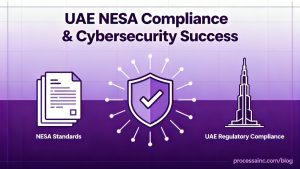As cyber threats grow more advanced, UAE NESA compliance has become a critical regulatory requirement for both government and private entities operating in the region. The National Electronic Security Authority (NESA) established a set of Information Assurance Standards (IAS) designed to ensure that organizations maintain a strong cybersecurity posture aligned with national objectives.
Whether you’re a financial institution, healthcare provider, or technology-driven enterprise, compliance with NESA guidelines demonstrates your commitment to safeguarding sensitive data and national digital infrastructure. To better understand the framework, you can also explore our detailed article, What Is NESA and Why It Matters for Your Cybersecurity Framework in the UAE.
Understanding the Purpose of NESA Compliance
The NESA Information Assurance Standards were introduced to unify cybersecurity practices across UAE organizations and reduce national-level risks. These standards provide minimum security controls across multiple domains, including:
-
Access control and identity management
-
Network security and encryption
-
Incident response and recovery
-
Asset management and risk assessment
For businesses, aligning with these guidelines helps minimize vulnerabilities and ensures resilience against emerging cyber threats. To learn more about building a compliant framework, you may also refer to Achieving NESA UAE Compliance: A Step-by-Step Cybersecurity Roadmap for 2025.
Key Steps to Prepare for UAE NESA Compliance
Preparing for NESA compliance requires a structured approach, strategic planning, and the right expertise. Below are essential steps to guide your organization through the process.
1. Conduct a Gap Assessment
Begin your compliance journey with a gap assessment. This involves evaluating your current cybersecurity framework against NESA requirements. The assessment highlights areas that fall short and helps you prioritize remediation based on risk and business impact.
2. Develop a Compliance Roadmap
Next, build a detailed roadmap outlining timelines, policies, technologies, and workflows required for alignment. Executive leadership should be involved early to ensure proper budgeting and resource allocation. A clear roadmap keeps projects on track and reduces compliance delays.
3. Implement Security Controls
Once gaps are identified, start implementing the required controls. These may include access control enhancements, vulnerability management, network segmentation, data classification, and encryption measures. Continuous monitoring is essential to ensure long-term compliance and operational safety.
4. Train and Build Awareness
Employees play a significant role in maintaining security. Regular training helps staff understand compliant data handling, secure practices, and incident reporting procedures. Awareness programs reduce risks caused by human error and strengthen your defense from within.
5. Partner with a Cybersecurity Consultancy
Working with a trusted partner like Processa Inc’s Cybersecurity Consultancy Services can simplify your journey to compliance. Processa’s experts offer comprehensive NESA compliance audits, policy implementation, and ongoing advisory support to ensure your business remains secure and audit-ready.
Benefits of Achieving NESA Compliance
Meeting NESA standards offers long-term value beyond regulatory alignment. Key benefits include:
-
Enhanced data protection and reduced cyber risk
-
Improved incident response and business continuity readiness
-
Greater trust from clients, partners, and regulators
-
A competitive advantage for the public sector and high-value contracts
Embedding NESA controls into your cybersecurity strategy creates a strong, sustainable digital foundation.
Frequently Asked Questions
Q1: Who must comply with UAE NESA standards?
NESA compliance applies to all organizations that support critical national infrastructure, including sectors such as energy, banking, healthcare, transportation, and government.
Q2: How often should organizations assess NESA compliance?
Annual audits are recommended. Regular assessments ensure ongoing compliance, especially as cyber regulations and security threats continue evolving.
Q3: Can SMEs also benefit from NESA compliance?
Absolutely. Small and medium businesses gain stronger data protection, increased customer trust, and better resilience from NESA-aligned practices—even if regulatory requirements don’t formally apply.



